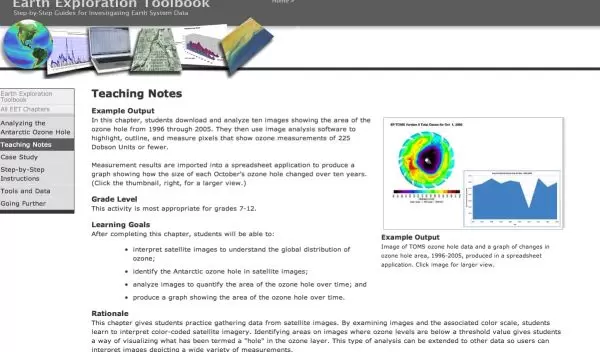
The Earth Exploration Toolbook Wins SPORE Award
On September 29, the Earth Exploration Toolbook (EET) was awarded the Science Prize for Online Resources in Education (SPORE) for being an innovative, free online resource for science education.
The EET is a National Science Foundation- (NSF) funded, free online Web site that provides resources for educators and students to access and effectively use data and data analysis tools related to the Earth sciences.
Science magazine is published by the American Association for the Advancement of Science (AAAS) and awards the SPORE prize "to encourage innovation and excellence in education, as well as to encourage the use of high-quality on-line resources by students, teachers and the public."
Participants were judged by the editors of Science and a panel consisting of teachers and researchers in relevant fields, chaired by the Editor-in-Chief of Science. Winners were invited to write an essay describing their resources for publication in Science.
"The overarching goal of the Earth Exploration Toolbook is to enable students and educators to investigate and answer scientific questions that are of interest and relevant to them and their communities," said Tamara Ledley, a senior scientist and chair of the Center for Science Teaching and Learning at Technical Education Resource Centers (TERC). "As we prepare students to become the policy makers, scientists and citizens of tomorrow, we need to assure that they have the skills to explore and draw conclusions from valid scientific data."
The EET includes 43 chapters that each focus on a different set of Earth science data and/or a data analysis tool. Data are accessed from sources such as the National Climatic Data Center, the U.S. Geological Survey, the National Center for Atmospheric Research, the National Geophysical Data Center, the National Snow and Ice Data Center, the National Oceanic and Atmospheric Administration (NOAA) and NASA.
"These datasets are collected by scientists to conduct scientific research and are generally difficult to find and use," said Ledley.
"The Earth Exploration Toolbook provides step-by-step instructions so that teachers and students can conduct analyses around scientific concepts or issues using these datasets and various tools."
Each chapter has a specific "Case Study" and a set of "Teaching Notes" that provide a summary of learning goals, background information, national science and geography standards. Chapter examples include: "Analyzing Plate Motion Using EarthScope GPS Data," "Detecting El Niño in Sea Surface Temperature Data," "Exploring Characteristics of Wetlands," "Measuring Distance and Area in Satellite Images" and "Climate History from Deep Sea Sediments."
Ledley explained that the EET has been used to educate teachers on how to use data analysis tools and integrate these resources into their curriculum through a professional development program funded by the NSF National STEM Education Distributed Learning (NSDL) program and the NSF Innovative Technology Experiences for Students and Teachers (ITEST) program.
"I think that teachers find that they can really engage their students in thinking through and exploring scientific concepts when they are using real data and even more importantly addressing scientific issues that are relevant to their lives," said Ledley.
The inspiration for EET developed out of a (NSF-POWER program) project led by Ledley in 1998, to teach high school students about the influence of El Niño on polar oceans. Ledley explained that there was a lack of a mechanism and process that students could use to search for relevant data. Although Ledley eventually found the appropriate data in a particular archive, the format of the datasets prevented the students from gathering the specific data that they sought. Ledley had to work with the technical support staff of the archive to obtain the data.
"All of this defeated the purpose of having the students actively involved and vested in the investigation," said Ledley.
Three years later, Ledley attended a meeting with a group of scientists and educators who were a part of the effort to develop the Digital Library for Earth System Education (DLESE). Ledley explained that the group had difficulty in determining how Earth science datasets could be more accessible to students--which was the same challenge that arose when she led the El Niño and polar ocean study.
"The idea to develop an online resource that would give educators the information they needed to access and effectively use Earth science datasets was conceived at that meeting," said Ledley.
Ledley cites positive feedback from educators and their experience using EET, quoting an educator who noted the following:
"After implementing the first few activities related to EET chapters, it was apparent that students were highly engaged in the problems addressed by the activities. Reflection statements submitted by students and classroom discussions indicated a new level of interest in the content and development of valuable new skills working with the tools."
Regarding future plans for EET, Ledley said, "We would like to partner with other scientific research projects (ranging from large scale research projects to individual scientists) to develop the outreach component of their effort and make the data they collect accessible and usable by educators and students. We would also like to continue to provide professional development programs that facilitate the use of Earth Exploration chapters."
